U.S. SETS OUT TO RECAPTURE ATTU ISLAND
Attu, Aleutian Islands, Alaska • May 11, 1943
The Japanese assault on Alaska’s Aleutian Islands began with a carrier-based aerial attack on June 3 and 4, 1942, that targeted U.S. Navy and Army facilities at Dutch Harbor on Amaknak Island (see map below), the most populous island in the Alaskan archipelago. The carrier strike force was part of a coordinated operation with a much larger Japanese strike force that was en route to capture Midway Atoll. The Japanese campaign against Midway was to both occupy the 2.4‑sq-mile/6.2‑sq-kilometer atoll, which is roughly equidistant between Japan and the U.S. mainland, and destroy the remaining U.S. naval forces in the Pacific in the half-year following December’s horrific beating their navy had inflicted on the U.S. Pacific Fleet anchored at Pearl Harbor, Hawaii. The smaller Aleutian campaign was meant to extend Japan’s defensive perimeter into the North Pacific in order to make it more difficult for U.S. naval and air forces to attack the Japanese Home Islands and Japan’s naval bases in the Kurile Islands from the Aleutians after the Doolittle Raid on Tokyo on April 18, 1942.
U.S. Dutch Harbor facilities escaped with moderate damage and loss of life (78 dead). Two days later, on June 6 and 7, 1942, a Japanese invasion force of infantry, marines, and civilian laborers occupied the Aleutian islands of Kiska, home to a U.S. weather post, and Attu, the western-most island 180 miles/290 kilometers from Kiska. Neither of the islands’ Unangax (or Aluets) offered serious resistance. Only the month before, the U.S. Navy had offered to evacuate Attu Island but the offer was declined. The Japanese, however, evacuated all 42 native Aluet residents in September 1942, interning them on the northern Japanese island of Hokkaido; only 25 Attu POWs survived internment. The U.S. military correctly feared both Kiska and Attu could be turned into strategic Japanese airbases from which Japan could launch aerial attacks against mainland Alaska and the rest of the U.S. West Coast states. However, the remoteness of the 2 islands and the challenges of weather and terrain delayed for nearly a year a U.S.-Canadian response to the Japanese occupation.
Attu is a small island, 35 miles/56 kilometers by 15 miles/24 kilometers, but the rocky, snow-covered terrain is formidable most months of the year. Retaking the island was set for this date, May 11, 1943, because military experts thought the Japanese garrison there was smaller than that on Kiska. (On August 15, 1943, a U.S./Canadian invasion force of over 34,000 men stormed Kiska in the wake of a sustained 3‑week barrage, only to discover that the Japanese Navy, making clever use of darkness and Arctic fog, had evacuated all 5,183 men in the garrison without being spotted.)
Operation Landcrab, the more than 2-week Battle of Attu, effectively ended with a banzai charge on May 29, 1943, that broke through American lines. In the brutal hand-to-hand finale and suicide with hand grenades almost all of the remaining enemy counted among the dead (over 2,351 in all) or captured (28), although sporadic fighting continued until early July 1943. U.S. casualties amounted to 3,929: more than 580 men killed, 1,148 wounded, with another 1,200 suffering severe injuries from the cold and wet weather. An additional 614 soldiers died from disease, and 318 from miscellaneous causes, mainly Japanese booby traps or friendly fire due to the heavy fog. In Tokyo Bay a powerful Japanese armada of carriers, battleships, cruisers, and destroyers had assembled in late May in preparation for a sortie to repel the American attempt to recapture Attu and the sea highway leading to the U.S. West Coast. It was weeks late to have affected the outcome. Instead, the Attu disaster prompted the Japanese Navy to dispatch 7 destroyers to withdraw their garrison from nearby Kiska overnight, thereby bringing closure to the 14‑month Japanese occupation of the U.S. Aleutian Islands on July 28, 1943, and lifting the threat to America’s West Coast from the north.
Battle of Attu: Retaking the U.S. Aleutians, May 11–30, 1943
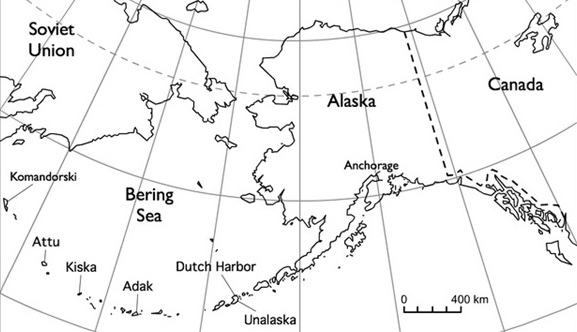 |
Above: The Aleutians are a chain of small, volcanic rock islands that extend into the North Pacific from the mainland of Alaska, in 1943 a U.S. territory (not a state). Despite having a cold, barren, and largely nasty reputation, the U.S. Aleutian Islands were of immense strategic value to both the Japanese and the Americans in World War II. The map shows the 3 islands targeted by the enemy in early June 1942. Dutch Harbor, the most populous and heavily defended of the islands, was bombed over 2 days, June 3–4, 1942, while Kiska and Attu were invaded and occupied by Japanese forces until July 1943. Following 2 naval bombardments in February and March 1943, efforts by U.S. armed forces to expel the invaders on Attu Island kicked off on May 11, 1943. Three battleships, 10 destroyers, an escort carrier with 24 planes, with assistance from Army B‑24 Liberators and B‑25 Mitchell bombers and P‑38 Lightning fighters stationed on Adak Island, provided the muscle behind the 15,000 men of the U.S. 7th Infantry Division, which constituted the Amphibious Force North Pacific under Rear Adm. Francis Rockwell.
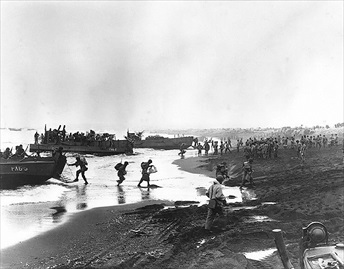 | 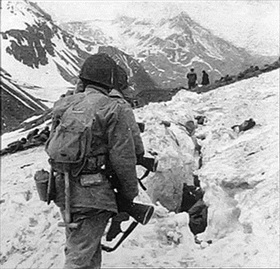 |
Left: Soldiers of the U.S. 7th Infantry Division unloading landing craft on the beach at Massacre Bay, Attu Island, May 12, 1943. Massacre Bay provided sandy invasion beaches for the Southern Landing Force, consisting of 2 infantry regiments (4 battalions). A smaller Northern Landing Force consisting of 2 battalions and a 410‑man scout detachment that included Aleut Indians landed in dense fog 30 miles/48 kilometers away on the west arm of Holtz Bay (Red Beach), the only other sandy beach on Attu Island. Because the enemy never expected landings where they occurred, neither force met initial resistance. Across the bay on the tip of a mountainous peninsula formed by Holtz Bay and Chichagof Harbor was Attu Village (1942 population, 40), site of a pre-war U.S. Navy-operated weather station now augmented by enemy housing and storage areas. Temporarily dug into the peninsula’s high ground was the main Japanese force for a total of between 2,000 and 2,600 men equipped with small arms and a few artillery pieces. Entrenched enemy positions in the mouths of the passes between Massacre and Holtz Bays retarded progress. Rescue being out of the question (a U.S. task force had turned away a Japanese relief convoy bound for the Aleutians on March 26), the Japanese meant to fight to the death. Aerial bombing, strafing, and naval guns rained shells down on Japanese defenders as they retreated under steady pressure toward Chichagof Harbor.![]()
Right: U.S. troops navigate through snow, ice, and fog during the Battle of Attu, May 1943. Mountains rose 2,000 ft/610 m above sea level and sloped steeply into narrow, treeless valleys. Under men’s feet was thawed tundra muskeg, boggy land covered in sphagnum moss. Vehicular traffic (trucks and tractors) was impossible, so supplies, equipment, artillery, and munitions had to be manhandled over steep and narrow passes and across valley floors. Two thousand yards/1.8 kilometers (even a quarter of that!) was a good day’s gain.
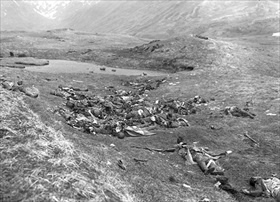 | 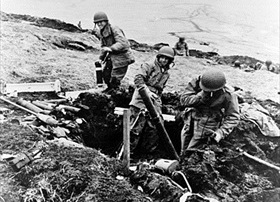 |
Left: The retreat of the enemy under U.S. pressure was attended by stubborn fighting south and southeast of Chichagof Harbor, i.e., south of Attu Village. In this photo dead Japanese lie where they fell after a do-or-die final banzai charge of 300 Japanese against American forces on May 29, 1943. Between 250 and 275 of the attackers, fighting well and achieving considerable early success, were killed or murdered by their comrades or committed suicide by pulling pins on grenades they held to their chests; the few survivors scattered, some becoming snipers. In a single mopping-up operation, U.S. soldiers killed 61 snipers.![]()
Right: On May 30, 1943, U.S. soldiers, meeting little opposition, captured Chichagof Harbor (Attu Village) and seized all the enemy housing and storage areas. The body count in 2 days of combat, the 29th and the 30th, stood at more than 400. Seen here are soldiers from the 7th U.S. Infantry Division launching trench mortar shells over a ridge into a Japanese position on June 4, 1943. Though the battle for Attu Island essentially ended a week earlier, small groups of Japanese continued to fight until early July 1943. A March 1945 report put combat losses as follows: U.S. killed, 552, 1,140 wounded. Another 932 died from disease, exposure, and accidents, while over 1,200 suffered severe injuries from the arctic cold and wet operations. Japanese killed, 2,350, 24 prisoners—no officers. As a percentage of troops involved, Attu was the second costliest U.S. battle in the Pacific, exceeded only by Iwo Jima.

 History buffs, there is good news! The Daily Chronicles of World War II is now available as an ebook for $4.99 on Amazon.com. Containing a year’s worth of dated entries from this website, the ebook brings the story of this tumultuous era to life in a compelling, authoritative, and succinct manner. Featuring inventive navigation aids, the ebook enables readers to instantly move forward or backward by month and date to different dated entries. Simple and elegant! Click
History buffs, there is good news! The Daily Chronicles of World War II is now available as an ebook for $4.99 on Amazon.com. Containing a year’s worth of dated entries from this website, the ebook brings the story of this tumultuous era to life in a compelling, authoritative, and succinct manner. Featuring inventive navigation aids, the ebook enables readers to instantly move forward or backward by month and date to different dated entries. Simple and elegant! Click 











